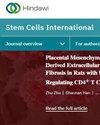不同来源间充质干细胞对膝骨关节炎短期和长期临床疗效的比较分析:网络元分析
IF 3.3
3区 医学
Q2 CELL & TISSUE ENGINEERING
引用次数: 0
摘要
背景。关节注射间充质干细胞(MSCs)已成为治疗骨关节炎(OA)的一种新方法。然而,不同来源的间充质干细胞对治疗OA患者的有效性仍不明确。因此,本研究旨在探讨不同来源间充质干细胞的有效性和安全性之间的差异。材料与方法。出于纳入考虑,我们检索了试验登记和已发表的数据库,包括 PubMed、Cochrane Library、Embase 和 Web of Science 数据库。我们使用 Revman (V5.3)、STATA (V16.0) 和 R (V4.0) 进行数据分析,并使用 Cochrane 偏倚风险工具评估研究质量。我们根据研究的随访时间得出了 6 个月和 12 个月的结果指标,包括视觉模拟量表 (VAS) 评分、WOMAC 评分、WOMAC 疼痛、WOMAC 功能限制和 WOMAC 僵硬度。短期疗效的评估时间定为 6 个月,而 12 个月是大多数研究评估长期疗效的最长随访时间。结果。对文献质量的评估显示,纳入的研究在方法学方面质量上乘。荟萃分析显示,与对照组相比,不同来源的间充质干细胞能更有效地改善膝关节 OA(KOA)患者的膝关节功能和疼痛。网络荟萃分析结果显示:短期功能改善(随访6个月后评估各项指标)(WOMAC总分:骨髓间充质干细胞(BMMSC) vs. 脂肪间充质干细胞(ADMSC)(平均差异(MD)= -20.12,95% 置信区间(CI)-125.24 至 42.88),脐带间充质干细胞(UCMSC)(MD = -7.81,95% CI -158.13 至 74.99);WOMAC僵硬度:BMMSC vs. ADMSC(MD = -0.51,95% CI -7.27至4.29),UCMSC(MD = -0.75,95% CI -9.74至6.63);WOMAC功能限制:BMMSC vs. ADMSC (MD = -12.22, 95% CI -35.05 to 18.86), UCMSC (MD = -9.31, 95% CI -44.26 to 35.27))。BMMSC vs. ADMSC(MD = -0.5,95% CI -26.05至18.61),UCMSC(MD =-1.03,95% CI -30.44至21.69);WOMAC功能限制:BMMSC vs. ADMSC (MD = -5.18, 95% CI -316.72 to 177.1), UCMSC (MD = -8.33, 95% CI -358.78 to 218.76))。短期疼痛缓解情况(随访 6 个月后对各项指标进行评估)(VAS 评分:UCMSC vs. BMMSC,MD=-316.72 vs. 177.1):UCMSC vs. BMMSC(MD = -10.92,95% CI -31.79 to 12.03),ADMSC(MD = -14.02,95% CI -36.01 to 9.81),PLMSC(MD = -17.09,95% CI -46.31 to 13.17);WOMAC 疼痛缓解:BMMSC vs. ADMSC (MD = -11.42, 95% CI -39.52 to 11.77), UCMSC (MD = -6.73, 95% CI -47.36 to 29.15))。长期疼痛缓解(随访12个月后评估各项指标)(VAS评分:BMMSC vs. UCMSC(MD = -4.33,95% CI -36.81 to 27.08),ADMSC(MD = -11.43,95% CI -37.5 to 13.42);WOMAC疼痛缓解:UCMSC vs. ADMSC(MD = 0.23,95% CI -37.87 to 38.11),BMMSC(MD = 5.89,95% CI -25.39 to 51.41))。根据 GRADE 评分系统,WOMAC、VAS 和 AE 评分的质量较低。结论Meta分析表明,与对照组相比,间充质干细胞能有效治疗KOA,改善疼痛和膝关节功能。就 KOA 患者的功能改善而言,短期(6 个月随访)和长期(12 个月随访)结果均表明,虽然大多数治疗方法之间的差异并无统计学意义,但骨髓间充质干细胞可能比其他来源的间充质干细胞更具优势。此外,在缓解 KOA 患者疼痛方面,BM-间充质干细胞和 UC-间充质干细胞可能比 ADMSCs 更有优势,但大多数研究之间的差异并无统计学意义。因此,这项研究表明,BM-间充质干细胞可能比其他来源的间充质干细胞更具临床优势。本文章由计算机程序翻译,如有差异,请以英文原文为准。
Comparative Analysis of Short-Term and Long-Term Clinical Efficacy of Mesenchymal Stem Cells from Different Sources in Knee Osteoarthritis: A Network Meta-Analysis
Background. Joint articular injection of mesenchymal stem cells (MSCs) has emerged as a novel treatment approach for osteoarthritis (OA). However, the effectiveness of MSCs derived from different sources in treating OA patients remains unclear. Therefore, this study aimed to explore the differences between the effectiveness and safety of different sources of MSCs. Materials and Methods. For inclusion consideration, we searched trial registries and published databases, including PubMed, Cochrane Library, Embase, and Web of Science databases. Revman (V5.3), STATA (V16.0), and R (V4.0) were utilized for conducting data analysis, while the Cochrane Risk of Bias Tool was employed for assessing the quality of the studies. We derived outcome measures at 6 and 12 months based on the duration of study follow-up, including visual analog scale (VAS) score, WOMAC score, WOMAC pain, WOMAC Functional Limitation, and WOMAC stiffness. The evaluation time for short-term effectiveness is set at 6 months, while 12 months is utilized as the longest follow-up time for most studies to assess long-term effectiveness. Results. The evaluation of literature quality showed that the included studies had excellent methodological quality. A meta-analysis revealed that different sources of MSCs improved knee function and pain more effectively among patients suffering from knee OA (KOA) than controls. The results of the network meta-analysis showed the following: short-term functional improvement (the indexes were evaluated after 6 months of follow-up) (WOMAC total score: bone marrow-derived MSC (BMMSC) vs. adipose-derived MSC (ADMSC) (mean difference (MD) = −20.12, 95% confidence interval (CI) −125.24 to 42.88), umbilical cord-derived MSC (UCMSC) (MD = −7.81, 95% CI −158.13 to 74.99); WOMAC stiffness: BMMSC vs. ADMSC (MD = −0.51, 95% CI −7.27 to 4.29), UCMSC (MD = −0.75, 95% CI −9.74 to 6.63); WOMAC functional limitation: BMMSC vs. ADMSC (MD = −12.22, 95% CI −35.05 to 18.86), UCMSC (MD = −9.31, 95% CI −44.26 to 35.27)). Long-term functional improvement (the indexes were evaluated after 12 months of follow-up) (WOMAC total: BMMSC vs. ADMSC (MD = −176.77, 95% CI −757.1 to 378.25), UCMSC (MD = −181.55, 95% CI −937.83 to 541.13); WOMAC stiffness: BMMSC vs. ADMSC (MD = −0.5, 95% CI −26.05 to 18.61), UCMSC (MD = −1.03, 95% CI −30.44 to 21.69); WOMAC functional limitation: BMMSC vs. ADMSC (MD = −5.18, 95% CI −316.72 to 177.1), UCMSC (MD = −8.33, 95% CI −358.78 to 218.76)). Short-term pain relief (the indexes were evaluated after 6 months of follow-up) (VAS score: UCMSC vs. BMMSC (MD = −10.92, 95% CI −31.79 to 12.03), ADMSC (MD = −14.02, 95% CI −36.01 to 9.81), PLMSC (MD = −17.09, 95% CI −46.31 to 13.17); WOMAC pain relief: BMMSC vs. ADMSC (MD = −11.42, 95% CI −39.52 to 11.77), UCMSC (MD = −6.73, 95% CI −47.36 to 29.15)). Long-term pain relief (the indexes were evaluated after 12 months of follow-up) (VAS score: BMMSC vs. UCMSC (MD = −4.33, 95% CI −36.81 to 27.08), ADMSC (MD = −11.43, 95% CI −37.5 to 13.42); WOMAC pain relief: UCMSC vs. ADMSC (MD = 0.23, 95% CI −37.87 to 38.11), BMMSC (MD = 5.89, 95% CI −25.39 to 51.41)). According to the GRADE scoring system, WOMAC, VAS, and AE scores were of low quality. Conclusion. Meta-analysis suggests MSCs can effectively treat KOA by improving pain and knee function compared to control groups. In terms of functional improvement in KOA patients, both short-term (6-month follow-up) and long-term (12-month follow-up) results indicated that while the differences between most treatments were not statistically significant, bone marrow-derived MSCs may have some advantages over other sources of MSCs. Additionally, BM-MSCs and UC-MSCs may offer certain benefits over ADMSCs in terms of pain relief for KOA patients, although the variances between most studies were not statistically significant. Therefore, this study suggests that BM-MSCs may present clinical advantages over other sources of MSCs.
求助全文
通过发布文献求助,成功后即可免费获取论文全文。
去求助
来源期刊

Stem Cells International
CELL & TISSUE ENGINEERING-
CiteScore
8.10
自引率
2.30%
发文量
188
审稿时长
18 weeks
期刊介绍:
Stem Cells International is a peer-reviewed, Open Access journal that publishes original research articles, review articles, and clinical studies in all areas of stem cell biology and applications. The journal will consider basic, translational, and clinical research, including animal models and clinical trials.
Topics covered include, but are not limited to: embryonic stem cells; induced pluripotent stem cells; tissue-specific stem cells; stem cell differentiation; genetics and epigenetics; cancer stem cells; stem cell technologies; ethical, legal, and social issues.
 求助内容:
求助内容: 应助结果提醒方式:
应助结果提醒方式:


